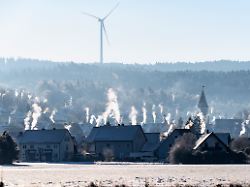Gas and electricity cheaper
Costs for price brakes melt together
By Max Borowski
01/10/2023, 5:30 p.m
The federal government has planned 200 billion euros for the third major relief package. A large part of this is earmarked for the electricity and gas price brake. Only a fraction of these resources are needed. It’s not just the very mild winter weather that has eased energy prices.
It has been in force since January 1st, the German gas and electricity price brake. Even if the monthly relief amounts for private gas customers are not paid out until March, households and small businesses can expect that from the beginning of this year they will be left with 80 percent of their previous year’s consumption at a maximum cost of twelve cents per kilowatt hour (kWh). For electricity, it is a maximum of 40 cents per kWh. For January and February, the difference between these prices and the prices actually paid will be refunded retrospectively. For the federal government, the cost clock is running – and much slower than expected. Due to falling energy prices, the bill for the price brakes is likely to be many billions of euros lower than was foreseen when the relief package that became known as the “double boom” was planned.
In late summer, the gas price on the stock exchange had temporarily shot up to more than 300 euros per megawatt hour, and the electricity price went up to over 700 euros per megawatt hour. The fear: Should this record price level persist or even rise and be passed on to consumers, the energy costs for households and companies would multiply. So, at the suggestion of a commission of experts, the federal government decided to cap the costs for basic consumption at 12 or 40 cents per kilowatt hour. There are separate conditions for large industrial consumers.
The federal government budgeted 200 billion euros for the entire relief package, which was already the third at the time. More than 50 billion are earmarked for the gas price brake alone. In view of the current price development, the actual effort should only be a fraction of this. There are gas customers who currently actually have to pay more than 20 cents or even 30 cents per kilowatt hour. However, this only affects a minority, who are stuck with high basic supply tariffs or who have concluded new contracts with gas suppliers, usually for one year, at the worst possible time. According to the comparison portals Verivox and Check24, new contracts are currently being offered from around 14 cents, i.e. only 2 cents above the price cap level.
Wind and nuclear power help
Energy expert Marco Wünsch from the economic research institute Prognos expects that the average reimbursement amount under the gas price brake will be 2 to 4 cents per kilowatt hour – for a consumption of around 240 terawatt hours. That would correspond to costs of 7 to 15 billion euros for the period of validity of the price brakes until next April, as Wünsch calculates in an interview with ntv.de. According to Wünsch, the rest of the gas consumption of households and tradesmen is still covered by cheap old contracts from the time before the Ukraine war, with prices well below 12 cents per kilowatt hour. So the gas price brake does not apply.
That leaves the big industrial consumers. According to Wünsch, they usually cover their gas requirements at short notice. This means that they will soon be benefiting from the significantly lower stock exchange prices and will receive little or no support from the gas price brake. Even with the electricity price brake, the costs should remain low. “The limit was set very high at 40 cents,” says Wünsch. The majority of consumers pay less.
Consumers and taxpayers alike owe the lower-than-expected cost of the relief measures to several developments that were not foreseeable when the package was being drafted in September. Above all, the winter has been unusually mild so far, explains Wünsch. In addition, electricity generation from wind turbines has recently increased significantly, and French nuclear power plants, many of which had failed in the summer and autumn, were brought back online faster than feared. This not only eased the situation on the electricity market, but also on the gas market. As a result, less natural gas is required to generate electricity.
